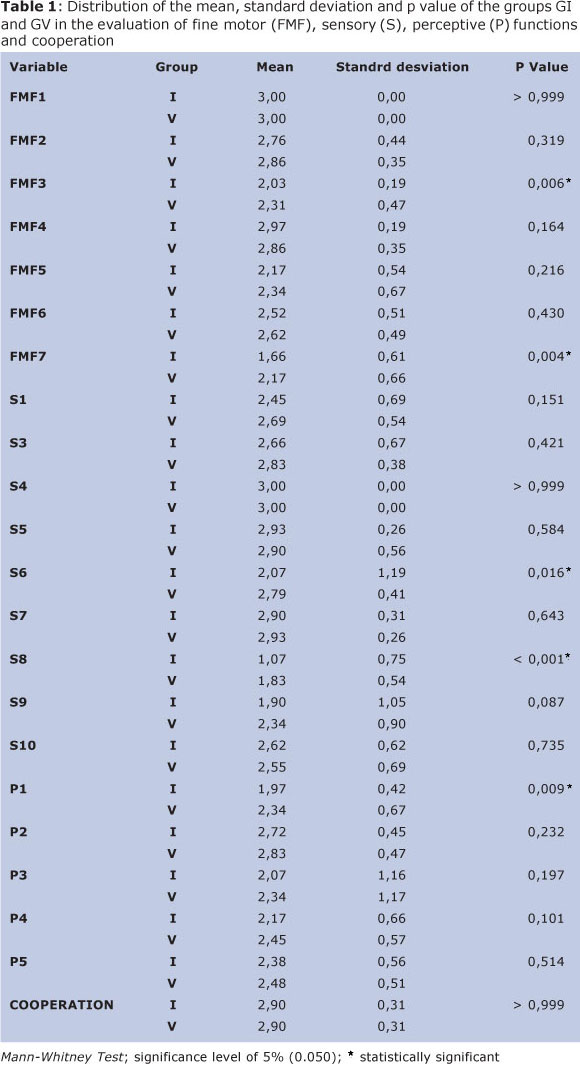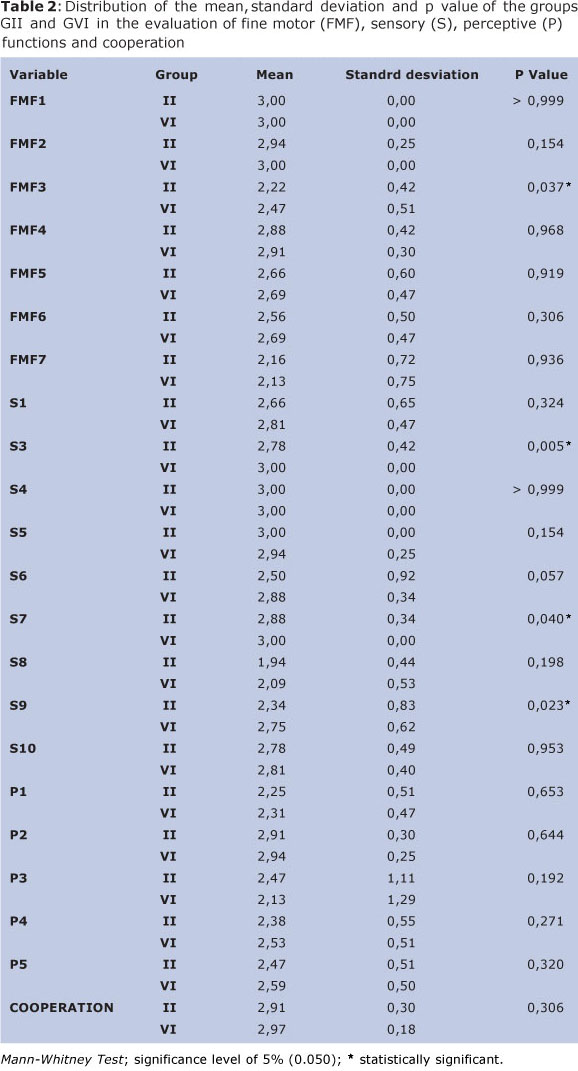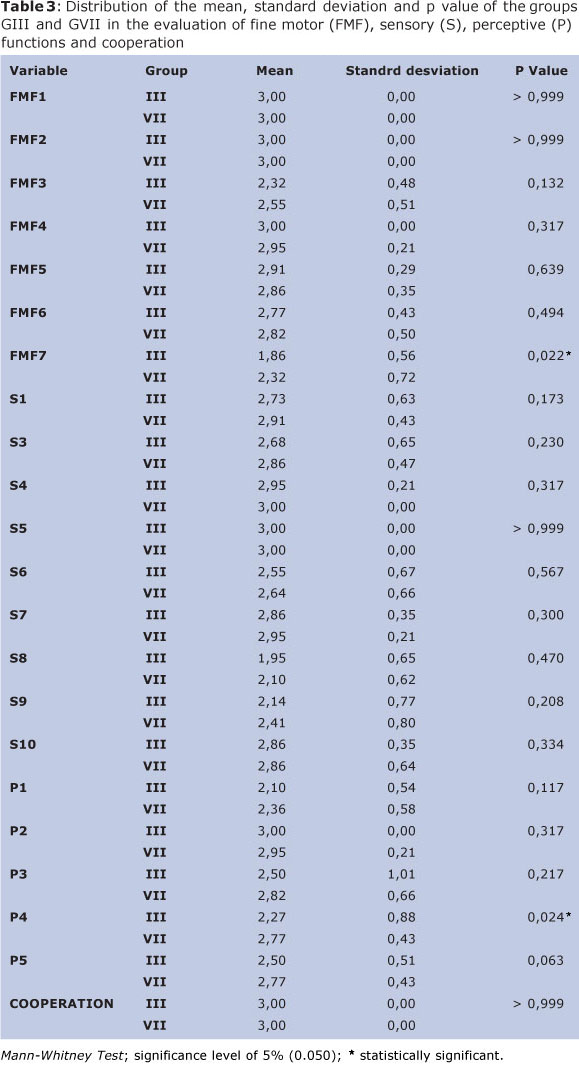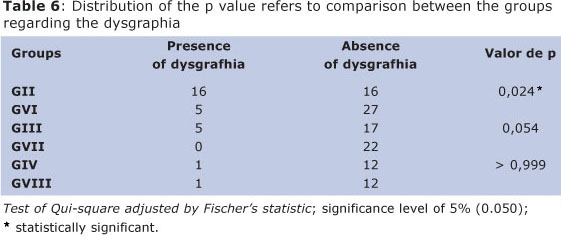Journal of Human Growth and Development
ISSN 0104-1282
Rev. bras. crescimento desenvolv. hum. vol.22 no.3 São Paulo 2012
ORIGINAL RESEARCH
Performance of children with learning difficulties in fine motor function and handwriting
Aline Cirelli CoppedeI; Paola Matiko Martins OkudaII; Simone Aparecida CapelliniIII
IOccupational Therapist. Professor at the Federal University of Triangulo Mineiro - FUTM - Uberaba - Minas Gerais, Brazil. Address: Praça Manoel Terra, 330, Postal Code: 38025-015. Uberaba - MG. Phone: (34) 3318-5075
IIOccupational Therapist of the Laboratory of Investigation of Learning Deviations (LILD), Faculty of Philosophy and Sciences, São Paulo State University - UNESP - Marilia (SP), Brazil. Address: St. Hygino Muzzy Filho, 737. Campus. Postal Code: 17525-900. Marilia - SP. Phone: 14-3402-1324
IIISpeech Therapist. Full Professor of the Department of Speech Language Therapist and Audiology. Professor of Postgraduate Program in Education of the Faculty of Philosophy and Sciences of São Paulo State University - UNESP - Marilia - São Paulo - Brazil. Address: St. Hygino Muzzy Filho, 737. Campus Universitário. CEP: 17525-900. Marilia - SP. Phone: 14-3402-1324
ABSTRACT
AIMS: This study aimed to compare and characterize the fine, sensory and perceptive function performance and handwriting quality between students with learning difficulties and students with good academic performance.
METHODS: This study comprised 192 students from 2nd to 4th grades, both genders, whose ages ranged from 7 to 11 years old. The students were distributed into: GI, GII, GIII and GIV, comprising 96 students with learning difficulties, and groups GV, GVI, GVII, GVIII comprising 96 students with good academic performance. The students were submitted to evaluation of fine motor, sensorial and perception functions and handwriting evaluation under dictation.
RESULTS: The results showed that the students with learning difficulties, from 1st to 3rd grade, had lower performance on tests of fine motor, sensory and perceptive function, when compared to the students with good academic performance in the same grade; the students from 4th grade, both groups, did not show changes on fine motor, sensory and perceptive function; and only the students of GII showed dysgraphia.
CONCLUSIONS: the results presented in this study suggest that the qualitative aspects of fine motor, sensory and perceptive skills reflect the integrity and maturity of central nervous system and can probably play an important role in early diagnosis of development disorders and consequently prevent academic disorders such as handwriting performance.
Key words: learning, motor skill, handwriting.
INTRODUCTION
Learning difficulty refers to a discrepancy between what is presumed that the child is potentially able to learn under a given situation in the classroom, and what the child really performs. It is considered in the literature as a barrier or obstacle which prevents learning during the enrollment and refers to assimilation of the proposed contents. It is also characterized by a heterogeneous group of events which lead to low academic performance in tasks, such as: reading, writing and mathematical-calculation and can be categorized as transient, besides occurring at any time in the teaching-learning process1-3.
Studies4-6 have indicated that for students with learning difficulties, motor changes may occur due to a number of environmental factors, which contribute to a delay in the development of the central nervous system and their executing functions (memory and attention), increasing the probability of deficits in motor development.
In the presence of learning difficulties there is higher probability of alterations for praxic and gnosic functions impairing dexterity, speed of object manipulation, accuracy of movement, hand posture and writing skills, and, consequently, the functional tasks, such as: buttoning, using scissors, handling coins, pencils and writing4,7,8.
Writing is one of the most refined actions and requires the integration of sensory, perceptual, cognitive and fine motor functions, and it is considered common for the child to present some difficulty in learning. Before being able to write, the children must develop many skills, such as maintaining body balance without the use of hands, grasp and release an object voluntarily, handle utensils, as spoon, scissors and pencils; besides being able to manipulate objects in their hands with dexterity, making the adjustments necessary to use them, when interacting in the environment9-11.
Changes at any level of fine motor function, since the capture of sensory information, the processing and sequencing until the motor act itself, lead to bad stroke of writing, known as dysgraphia. This difficulty can reach from 10% to 30% of students, among the population, and is characterized as: difficulty in writing, illegible handwriting, inappropriate form of the letter and spelling errors, thus, hampering the identification of writing 8, 10-13.
Therefore, it is important to know the profile of fine motor and writing skills of students with and without learning difficulties, because it can be used at the time of the speech language therapist, pedagogical and psychological differential diagnosis among learning disorders (dyslexia and learning disabilities) and the difficulties of learning14.
Based on the above, this study aimed to characterize and compare the performance of fine motor, sensory and perceptual functions and writing, among students with learning difficulties and with good academic performance.
METHODS
This study was approved by the Ethics Committee of the Faculty of Philosophy and Sciences of São Paulo State University - UNESP - Marilia - São Paulo - Brazil, under protocol number 3405/2006.
The study included 192 students aged from 7 years to 11 years and 11 months, both genders, who attended from 1st to 4th grades of elementary school, from two public schools in the city of Marilia-SP, and were divided into eight groups, as follows:
Group I (GI): composed by 29 students, from 7 to 8 years old, twenty (70%), male gender and nine (30%) female gender, with learning difficulty, from the 1st grade.
Group II (GII): composed by 32 students, from 8-9 years old, twenty-three (72%), male gender, and nine (28%), female gender, with learning difficulty, from the 2nd grade.
Group III (GIII): composed by 22 students, from 9-10 years old, fourteen (67%), male gender and eight (33%), female gender, with learning difficulty, from the 3rd grade.
Group IV (GIV): composed by 13 students, from 10-11 years of age, nine (69%), male gender and four (31%), female gender, with learning difficulty, from the 4th grade.
Group V (GV): composed by 29 students, from 7-8 years old, twenty (70%) male gender and nine (30%), female gender, without learning disabilities, from the 1st grade.
Group VI (GVI): composed by 32 students, from 8-9 years old, twenty-three (72%) male gender and nine (28%), female gender, without learning disabilities, from the 2nd grade.
Group VII (GVII): composed by 22 students, from 9-10 years old, fourteen (67%), male gender and eight (33%), female gender, without learning disabilities, from the 3rd grade.
Group VIII (GVIII): composed by 13 students, from 10-11 years old, nine (69%), male gender and four (31%), female gender, without learning disabilities, from the 4th grade.
The students of the groups with learning difficulties (GI to GIV) and groups without learning difficulties (GV to GVIII), were nominated by teachers based on their performances in the assessments such as: reading, writing and mathematical calculation on the 3rd and 4th quarters of the year. The sample of this study was matched according to gender, age and educational level.
For this study, we used the following procedures:
a) Consent Form: According to the resolution of the National Health Council 196/96, before the beginning of the assessments, parents or guardians of the selected patients signed a Informed Consent, allowing the study.
b) Evaluation of Fine Motor, Sensory and Perceptual Function15: This assessment tool involves areas that represent different subsystems of motor control, providing a means of evaluating the school age child. The assessment is divided into three parts:
- Fine motor function (FMF), which includes the following specific tests: Grips (fingertip, pencil grip, grab cylinder, stick with the palm of the hand, hold a key) (FMF1), Put coins into a box (FMF2) , pegboards (FMF3), Pour water from one glass to another (FMF4), Screw nuts onto a bolt (FMF5), Thread small beads on a string (FMF6) and finger-thumb opposition (FMF7).
- Sensory function (S): Position sense (SF1), Touch (S2), Pain (S3), Temperature (S4), Differentiation: sharp and blunt objects (S5); Stereognosis (S6), Graphesthesia (S7), Two points Discrimination (S8) and Extinction (S9).
- Perceptual Function (P): Imitation of postures (P1), Buttoning 5 buttons (P2,) Tie a bow (P3), Trace of a flower (P4) and Cut a circle (P5).
The item cooperation (COOP), refers to cooperation of the students in the realization of assessment tests.
The tests were designed to evaluate both hemi-bodies, and the score must be calculated by the simple average between them, that is, the sum of the punctuation for each hemi-body in the tests, divided by two. By the individual scores of each test, it is possible to get the final classification of the assessment, by adding the punctuation from all of them, and dividing by the total number of tests, which can demonstrate the following results: severe dysfunction (SD): average ranging from 0.0 to 0.9, moderate dysfunction (MD): average 1.0 to 1.9, mild (M): average 2.0 to 2.8, and no dysfunction (ND) average from 2.9 to 3.0.
c) Lorenzini Scale of Dysgraphia16: Assessment that allows to analyze the following aspects of writing: flowing lines, progeny and/or ascending lines, irregular space between words, retouched letters, curvatures and angles of the arches of the letters m, n , u and v, junction points, collisions and adherences, sudden movements, irregular in size and bad forms.
The overall score for each handwriting ranged from zero to seventeen points, being considered with dysgraphia every subject who obtained grade equal or above eight and a half points - equivalent to 50% of the overall score.
The Scale of Dysgraphia was not applied for 1st grade students, because at this stage, the child is not able to arrange a graphical representation, and a coherent final meaning. The objects are drawn loosely and the relationship between them is subjective. At this school stage, children have strokes that show immaturity, lack of control and irregularity on the graphic act. Despite their efforts, the writing ability of these students may appear very irregular, blurry, retouched and poorly distributed on the sheet.
The results were analyzed using the Mann-Whitney Test and Qui-square Test, adjusted by Fischer's statistic. The level of significance (p value) adopted was 5% (0.05) and was marked with an asterisk. For data analysis, it was used the SPSS (Statistical Package for Social Sciences), version 13.0.
RESULTS
In Table 1, it can be observed that the results analyzed statistically by Mann-Whitney Test, showed significant differences between GI and GV for tests FMF3, FMF7, S6, S8 and P1, which indicates that the students of GI had lower performance for the pegboards test, finger-thumb opposition, stereognosis, two-point discrimination, and imitation of postures, respectively, compared to students of the GV.

In Table 2, the results analyzed statistically by Mann-Whitney Test, showed significant differences between GII and GVI in the tests FMF3, S3, S7 and S9, indicating that students of the GII had lower performance for pegboards, discrimination of touch with the brush, graphesthesia and discrimination of two points respectively, compared to GVI students.

In Table 3, it can be observed a statistically significant difference between the groups GIII and GVII on the tests FMF7 and P4, indicating that the students of GIII had lower performance in the tests of finger-thumb opposition and trace of the figure respectively, compared to the students of group GVII.

In Table 4, it can be observed by the statistically analyzed results, that there was not significant difference between the groups with and without learning difficulties, from 4th grade students, when compared.

In table 5, it can observed with the analysis by Qui-square Test, adjusted by Fischer's statistic, that there was not statistically significant difference between the groups, in relation to the level of motor fine, sensory and perceptual dysfunction, presenting similar performance between the groups with and without learning difficulties, independent of the grade, because all the students presented mild dysfunction.
Table 6 presents the results statistically analyzed by the Qui-square Test, adjusted by Fischer's statistics, enabling to observe statistically significant difference between the groups GII and GVI, which indicates that the students of GII showed presence of dysgraphia.

DISCUSSION
According to the results presented in this study, it can observed that students with learning difficulties, from the 1st, 2nd, 3rd and 4th grades showed fine motor, sensory and perceptual performance lower than the students without learning difficulties, corroborating to the national6 and international17 study.
The students from the 1st grade (GI), showed difficulties concerning pegboard skills, fingers-thumb opposing, differentiation of sharp and blunt objects, two-point discrimination and imitation of postures. The students from the 2nd grade (GII), showed difficulties concerning pegboards, discrimination of touch with the brush, stereognosis and two-point discrimination, while the students from the 3rd grade (GIII), presented difficulties in performing fingers-thumb opposition and tracing figures.
According to the literature6,18-20, students with learning difficulties have problems in global and fine motor skills, showing a vulnerable motor profile for the performance of school motor tasks and daily activities.
The fine motor, sensory and perceptual changes impair normal development and the refinement of fine motor coordination during the natural sequence of development. These changes affect the way in which the coordination improvement occurs, for more complex activities, such as: using tools like pencils and scissors, or even the simple and independent use of the hands and fingers 6,7,10, justifying the immaturity of the students of GI and the low performance of GII students for writing activities.
Nevertheless, the results presented in this study suggest that, with the increase of the chronological age and school grade, students are more exposed to writing and, therefore, there is fine motor, sensory and perceptual refining, progressing towards a largest organization of sensory and motor systems10,21-23, justifying the absence of dysgraphia in students with and without school difficulties, from the 4th grade.
The fine motor, sensory and perceptual skills are gradually being refined with the sensory-motor integration in constant harmony, so that, at the end of this period, the student performs numerous sophisticated skills. Therefore, due to the improvement that occurs in visual perception, on visual skills to chase moving objects, within the speed reaction time, speed of movement and in sensor-motor integration, it is expected to occur an improvement on the writing track throughout the grades21,24,25.
The findings of this study evidenced that the assessment of fine motor, sensory and perceptual functions constitute an important element for the clinical and educational diagnosis. This suggests that qualitative aspects of the fine motor, sensory and perceptual skills reflect the integrity and maturity of the central nervous system and may, probably, play an important role in early diagnosis of the development disorders and, consequently, prevent academic disorders, as writing performance, for example.
During the study, the main limitation found, refers to the lack of international studies, focusing on learning difficulties, which could allow a comparative analysis of the criteria used, and the results obtained in this study. Most of the international studies are conducted with students with learning disorders (dyslexia and learning disabilities).
Thus, based on the findings of this research, we suggest that this study be replicated with other populations of students with learning difficulties, because this will enable the determination of a parameter to establish a profile of the fine motor, sensory and perceptual functions of students with learning difficulties, as well as the establishment of the relationship between these functions and dysgraphia and its consequences for the academic context of these students in the Brazilian reality.
From the results found in this study, it can concluded that students with learning difficulties from 1st to 3rd grade had lower performance on tests of fine motor, sensory and perceptual functions, compared to students without learning difficulties in the same grade.
In the population of this study, there was no significant evidence of dysfunction on the fine motor, sensory and perceptual functions, suggesting that altered fine motor skill, is not part of the learning difficulties frame, but this result should be observed carefully, because even so, the students with and without learning difficulties are classified with the presence of mild dysfunction.
Still, the results suggest that the dysgraphia identified in the students of the 2nd grade with learning difficulties may be due to low stimulation and experience with activities for fine motor, sensory and perception functions and writing. This finding is important, because it shows that dysgraphia can occur due to low exposure of children to writing tasks or by lack of investment in school activities which involve fine and global motor experiences in early literacy stage.
These findings indicate the necessity of adequate stimulation in the educational context for the development of fine motor, sensory and perceptual functions, in order to prevent and detect alterations which impair the handwriting performance and the writing of students who are initiating the literacy stage.
REFERENCES
01. Rolfsen AB, Martinez CMS. Programa de intervenção para pais de crianças com dificuldades de aprendizagem: um estudo preliminar. Paidéia. 2008; 18(39): 175-88. [ Links ]
02. Capellini AS, Silva APC, Silva C, Pinheiro FH. Avaliação e diagnóstico fonoaudiológico nos distúrbios de aprendizagem e dislexias. In: Zorzi JL, Capellini SA. Dislexia e outros distúrbios da leitura-escrita. 2ª. ed. São José dos Campos: Pulso Editorial; 2009. 95-111. [ Links ]
03. Silva APC, Capellini AS. Programa de remediação fonológica em escolares com dificuldades de aprendizagem. J Soc Bras Fonoaudiol. 2011; 23(1): 13-20. [ Links ]
04. Trevisan JG, Coppede AC, Capellini SA. Avaliação da função motora fina, sensorial e perceptiva em escolares com dificuldades de aprendizagem. Temas sobre Desenvolvimento. 2008; 16(94): 183-7. [ Links ]
05. Willrich A, Azevedo CCF, Fernandes, JO. Desenvolvimento motor na infância: influência dos fatores de risco e programas de intervenção. Rev de Neurociências. 2009; 17(1): 51-56. [ Links ]
06. Siqueira CM, Gurgel-Giannetti, J. Mau desempenho escolar: uma visão atual. Rev da Assoc Med Bras. 2011; 57(1): 78-87. [ Links ]
07. Summers J, Larkin D, Dewey D. Activities of daily living in children with developmental coordination disorder: dressing, personal hygiene, and eating skills. Hum Mov Sci. 2008; 27: 215-29. [ Links ]
08. Rosenblum S, Aloni T, Josman N. Relationships between handwriting performance and organizational abilities among children with and without dysgraphia: A preliminary study. Res Dev Disabil. 2010; 31(2): 502-509. [ Links ]
09. Case-Smith J, Heaphy T, Marr D, Galvin B, Koch V, Ellis MG et al. Fine motor and functional performance outcomes in preschool children. Am J Occup Ther. 1998; 52(10): 88-99. [ Links ]
10. Fukuda MTM, Okuda, PMM. Avaliação e Intervenção na disgrafia. In Capellini AS, Germano GD, Cunha VL, organizadores. Transtornos de aprendizagem e transtornos da atenção (da avaliação à intervenção). São José dos Campos: Pulso Editorial; 2010. p. 91-103. [ Links ]
11. Feder KP, Majnemer A. Handwriting development, competency and intervention. Dev Med Child Neurol. 2007; 49(4): 312 - 7. [ Links ]
12. Toniolo CS, Santos LC, Lourenceti MD, Padula, NA, Capellini SA. Caracterização do desempenho motor em escolares com transtorno do déficit de atenção com hiperatividade. Rev Psicopedag. 2009; 26(79): 33-40. [ Links ]
13. Nicolson RI, Fawcett AJ. Dyslexia, dysgraphia, procedural learning and the cerebellum. Cortex. 2011; 47(1): 117-127. [ Links ]
14. Capellini SA, Souza AV. Avaliação da função motora fina, sensorial e perceptiva em escolares com dislexia. In: Sennyey AL, Capovilla FC, Montiel JM, organizadores. Transtornos da aprendizagem da avaliação à reabilitação. São Paulo: Editora Artes Médicas; 2008. p. 55-64. [ Links ]
15. Beckung, E. Development and validation of a measure of motor and sensory function in children with epilepsy. Pediatr Phys Ther. 2000; 12: 24-35. [ Links ]
16. Lorenzini VL. (). Uma escala para detectar a disgrafia baseada na escala de Ajuriaguerra [Dissertação de mestrado não-publicada]. São Carlos: Universidade Federal de São Carlos; 1993. [ Links ]
17. Volman MJM, Schendel BMV, Jongmans MJ. Handwriting difficulties in primary school children: a search for underlying mechanisms. Am J Occup Ther. 2006; 60(4): 451-60. [ Links ]
18. Medina-Papst J, Marques I. Avaliação do desenvolvimento motor de crianças com dificuldades de aprendizagem. Rev Bras Cineantropom Desempenho Hum 2010; 12(1): 36-42. [ Links ]
19. Rosa Neto F, Santos APM, Weiss SLI, Amaro KN. Análise da consistência interna dos testes de motricidade fina da edm - escala de desenvolvimento motor. R. da Educação Física/UEM. 2010; 21(2): 191-197. [ Links ]
20. Amaro KN, Jatobá L, Santos APM, Rosa Neto F. Desenvolvimento motor em escolares com dificuldades na aprendizagem. Movimento & Percepção. 2010; 11(16): 39-47. [ Links ]
21. Gallahue DL, Ozmuz JC. Compreendendo o desenvolvimento motor: bebês, crianças e adolescentes e adultos. São Paulo: Ed. Phorte; 2001. [ Links ]
22. Conlon EG, Sanders MA, Wright CM. Relationships between global motion and global form processing, practice, cognitive and visual processing in adults with dyslexia or visual discomfort. Neuropsychologia, 2009; 47(3): 907-15. [ Links ]
23. Alloway TP, Archibald L. Working memory and learning in children with developmental coordination disorder and specific language impairment. J Learn Disabil. 2008; 41(3): 251-62. [ Links ]
24. Engel-Yeger B, Nagauker-Yanuv L, Rosenblum S. Handwriting performance, self-reports and perceived selfefficacy among children with dysgraphia. Am J Occup Ther. 2009; 63(2): 182 - 192. [ Links ]
25. Johnston DW, Nicholls MER, Shah M, Shields MA. Nature's experiment? handedness and early childhood development. Demography. 2009; 46(2): 281-301. [ Links ]
 Corresponding author:
Corresponding author:
Department of Speech Therapist and Audiology
Faculty of Philosophy and Sciences
São Paulo State University - UNESP
Marilia - São Paulo - Brazil
sacap@uol.com.br
Manuscript submitted Feb 16 2011
Accepted for publication Jul 25 2012














